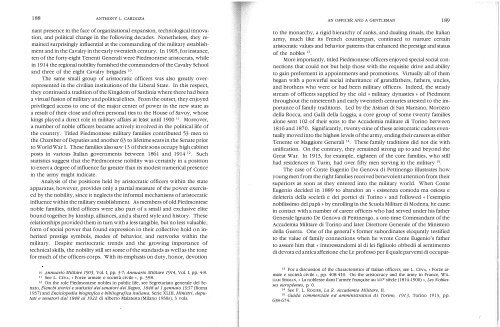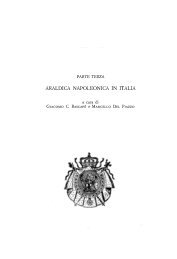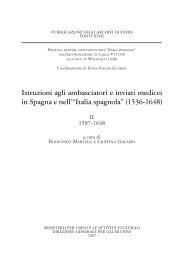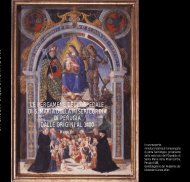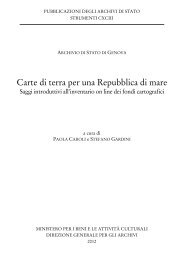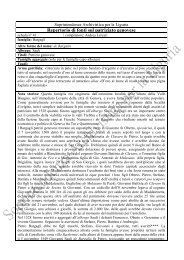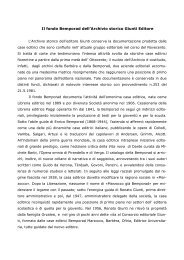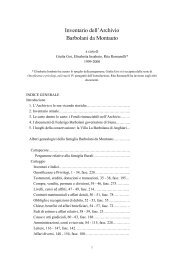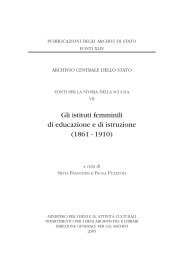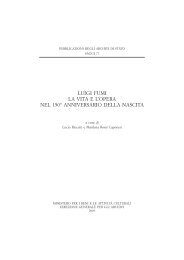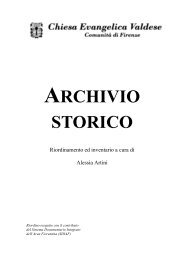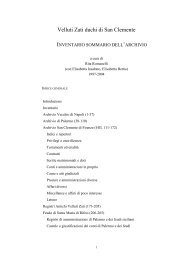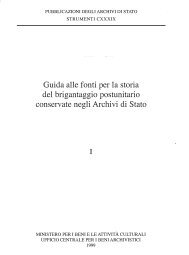esercito e città dall'unità agli anni trenta. tomo i - Sistema ...
esercito e città dall'unità agli anni trenta. tomo i - Sistema ...
esercito e città dall'unità agli anni trenta. tomo i - Sistema ...
You also want an ePaper? Increase the reach of your titles
YUMPU automatically turns print PDFs into web optimized ePapers that Google loves.
188 ANTHONY L. CARDOZA<br />
nant presence in the face of organizational expansion, technological innovation,<br />
and politica! change in the following decades. Nonetheless, they remained<br />
surprisingly influential at the commanding of the military establishment<br />
and in the Cavalry in the early twentieth century. In 1905, for instance,<br />
ten of the forty-eight Tenenti Generali were Piedmontese aristocrats, while<br />
in 1914 the regional nobility furnished the commanders ofthe Cavalry School<br />
an d three of the eight Cavalry brigades 10.<br />
The same small group of aristocratic officers was also greatly overrepresented<br />
in the civilian institutions of the Liberai State. In this respect,<br />
they continued a tradition of the Kingdom of Sardinia w h ere there had been<br />
a virtual fusi o n of military and politica! elites. From the outset, they enjoyed<br />
privileged access to one of the major center of power in the new state as<br />
a result of their dose and often personal ties to the House of Savoy, whose<br />
kings played a dire c t role in military affairs a t least until 1900 11. Moreover,<br />
a number of noble officers became actively involved in the political life of<br />
the country. Titled Piedmontese military families contributed 53 men to<br />
the Chamber of Deputies an d another 63 t o lifetime seats in the Senate prior<br />
to World War I. These families also saw 13 oftheir sons occupy high cabinet<br />
posts in various Italian governments between 1861 and 1914 12• Such<br />
statistics suggest that the Piedmontese nobility was certainly in a position<br />
to exert a degree of influence far greater than its modest numerica! presence<br />
in the army might indicate.<br />
Analysis of the positions held by aristocratic officers within the state<br />
apparatus, however, provides only a partial measure of the power exercised<br />
by the nobility, since it neglects the informai mechanisms of aristocratic<br />
influence within the military establishment. As members of old Piedmontese<br />
noble families, titled officers were also part of a small and exclusive elite<br />
bound together by kinship, alliances, and a shared style and history. These<br />
relationships provided them in turn with a less tangible, but no less valuable,<br />
form of social power that found expression in their collective hold on inherited<br />
prestige symbols, modes of behavior, and networks within the<br />
military. Despite meritocratic trends and the growing importance of<br />
technical skills, the nobility stili set some of the standards as well as the ton e<br />
for much of the officers corps. With its emphasis on duty, honor, devotion<br />
1o Annuario Militare 1905, Vol. I, pp. 3-7; Annuario Militare 1914, Vol. I, pp. 4-8.<br />
11 See L. CEVA, " Forze armate e società civile '' , p. 398.<br />
12 On the role Piedmontese nobles in public life, see Segretariato generale del Senato,<br />
Elenchi storici e statistici dei senatori del Regno, 1848 al l gennaio 193 7 (Roma<br />
193 7) and Enciclopedia biografica e bibliografica italiana, Serie XLIII, Ministri, deputati<br />
e senatori dal 1848 al 1922 di Alberto Malatesta (Milano 1930s), 3 vols.<br />
AN OFFICER AND A GENTLEMAN 189<br />
to the monarchy, a rigid hierarchy of ranks, and dualing rituals, the Italian<br />
army, much like its French counterpart, continued to nurture certain<br />
aristocratic values and behavior patterns that enhanced the prestige and status<br />
of the nobles 13.<br />
More importantly, titled Piedmontese officers enjoyed special social connections<br />
that could not but help those with the requisite drive and ability<br />
to gain preferment in appointments an d promotions. Virtually ali of them<br />
began with a powerful social inheritance of grandfathers, fathers, uncles,<br />
and brothers who were or had been military officers. Indeed, the steady<br />
stream of officers supplied by the old « military dynasties » of Piedmont<br />
throughout the nineteenth and early twentieth centuries attested to the importance<br />
of family traditions. Led by the Asinari di San Marzano, Morozzo<br />
della Rocca, and Galli della Loggia, a core group of some twenty families<br />
alone sent 102 of their sons to the Accademia militare di Torino between<br />
1816 and 1870. Significantly, twenty-nine of these aristocratic cadets eventually<br />
moved into the highest levels ofthe army, ending their careers as either<br />
Tenente or Maggiore Generali 14. These family traditions did not die with<br />
unification. On the contrary, they remained strong up to and beyond the<br />
Great War. In 1913, for example, eighteen of the core families, who stili<br />
had residences in Turin, had over fifty men serving in the military 15.<br />
The case of Conte Eugenio De Genova di Pettinengo illustrates how<br />
young men from the right families received benevolent attention from their<br />
superiors as soon as they entered into the military world. When Conte<br />
Eugenio decided in 1889 to abandon an «esistenza comoda ma oziosa e<br />
deleteria della società e dei portici di Torino " and followed «l'esempio<br />
nobilissimo del papà " by enrolling in the Scuola Militare di Modena, he carne<br />
in contact with a number of career officers w ho had served under his father<br />
Generale Ignazio De Genova di Pettinengo, a one-time Commandant of the<br />
Accademia Militare di Torino and later Direttore Generale of the Ministero<br />
della Guerra. One of the general's former subordinates eloquntly testified<br />
to the value of family connections when he wrote Conte Eugenio's father<br />
to assure him that « interessandomi al di lei figliuolo obbedii al sentimento<br />
di devota ed antica affezione che Le professo per il quale parvemi di occupar-<br />
13 For a discussion of the characteristics of Italian officers, see L. CEVA, " Forze armate<br />
e società civile ,, pp. 408-410. On the aristocracy and the army in France, WIL<br />
LIAM SERMAN, " La noblesse dans l'armée française au xrxe siècle (1814-1900) », Les Noblesses<br />
européenes, p. 6.<br />
14 See F. L. RoGIER, La R. Accademia Militare, II.<br />
15 Guida commerciale ed amministrativa di Torino, 1913, Torino 1913, pp.<br />
638-674.


